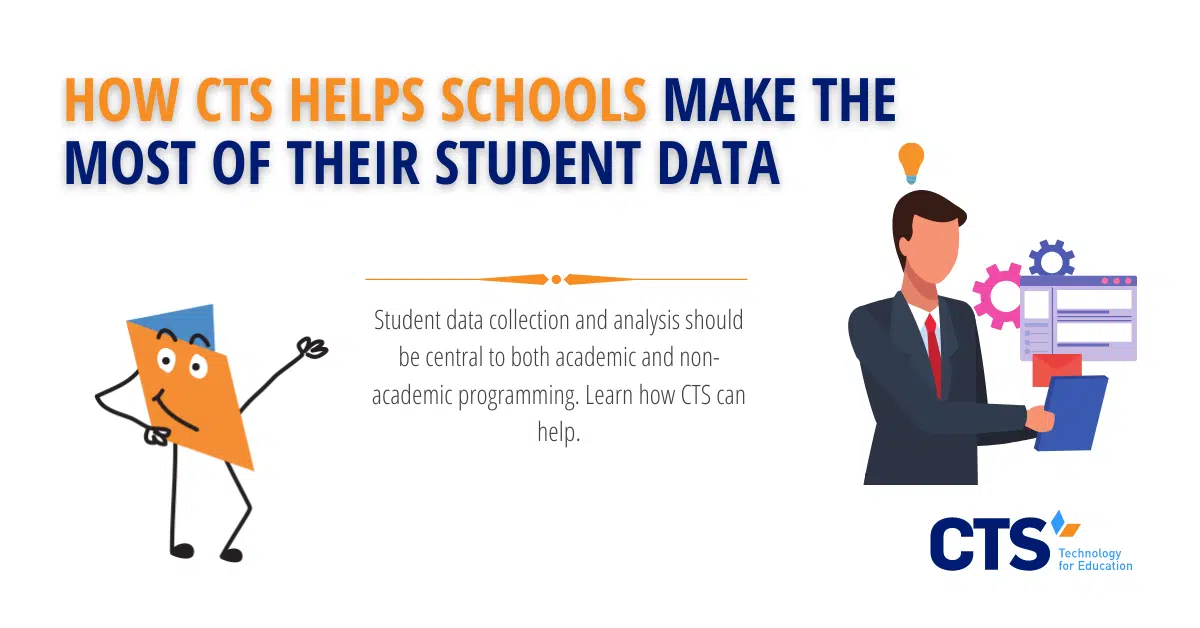Using student data effectively can drive instructional decision-making.
School leaders collect thousands upon thousands of student data points each year. From instructional data (e.g., student test scores, interim assessment results, instructional minutes) to non-instructional or “operational” data like student attendance, per-pupil expenditures, and immunization compliance, schools have deep repositories of student information at their disposal.
Unfortunately, collecting, organizing, and analyzing their student data into actionable insights can seem overwhelming for many school leaders. Between all of their other responsibilities—planning parent-teacher conferences, coordinating professional development activities, and observing instruction, to name just a few—few principals have the time and energy to create comprehensive data-review cycles.
By bridging this gap between the amount of student data at schools’ disposal and school leaders’ capacity to use that data, CTS can add tremendous value to its partners’ academic and non-academic programming.
At too many schools, student data is siloed.
Despite the amount of data they collect, at too many schools, student data remains siloed. Attendance, behavioral, and academic datasets are isolated from one another. These datasets might exist in entirely separate systems or, in some cases, may exist in the same system but fail to “speak” to one another.
For instance, if a school leader is meeting with a student’s family member to discuss the student’s lackluster attendance, having a ready-made report showing the link between the student’s attendance and academic performance could be powerful. Unfortunately, at too many schools, these insights aren’t easy to visualize or generate quickly.
Likewise, state and federal compliance reports often require school leaders to combine data from multiple different sources into a single report. Because many schools’ data architecture doesn’t align with these requirements, school leaders are often forced to spend valuable time and energy pulling multiple datasets from separate platforms manually, increasing the risk of inadvertent errors and ultimately detracting from other priorities.
In either case, whether for generating instructional insights or fast-tracking reporting requirements, breaking down the silos between a school’s student datasets is a critical first step school leaders can take to improve their school’s data usage.
Easy-to-use dashboards allow school leaders to quickly access their student data.
At CTS, one of the ways in which we help school leaders make better use of their student data is by, first, creating easy-to-use dashboards that display high-level school data at a glance.
We might, for instance, generate a single dashboard for a school that highlights key enrollment, attendance, demographic, behavioral, and instructional data for school leaders, all in one place. These dashboards are designed intentionally to update in almost real-time rather than having to pull new datasets day after day or week after week.
These data might reflect school-wide trends but can also be designed to generate class- and grade-level analyses, allowing school leaders to better target their interventions in places they’ll have the most impact. After a school administers an internal assessment, for example, the dashboard might reflect student performance at the school, grade, and class levels. From there, the school leader can develop a schedule for observing and coaching teachers whose students need additional support.
Finally, CTS dashboards can also allow leaders to get ahead of their school’s student-level data trends. Using predictive modeling, our team can help schools determine when and where academic or behavioral interventions will likely be needed in the future so that school leaders can plan their time accordingly.
Compliance and data reporting support can save leaders significant time and energy.
State and federal compliance reporting “season” tends to align with other busy times in school leaders’ calendars. For example, in many New York City schools, end-of-year compliance reporting collides with state testing days, placing additional stress on school leaders who are already stretched thin.
CTS eases this burden by helping school leaders collect granular student-, teacher-and school-level data that can be quickly combined to meet schools’ reporting needs. Assessment performance (whether internal or state-mandated), “passing” versus “not-passing” reports, attendance data, and instructional item analyses can all be collated in a timely manner. Rather than sitting down at their computers to complete a state or federal report late at night, long after students and teachers have gone home, we help school leaders get ahead of these and other annual reporting requirements.
At CTS, we help schools accomplish their unique missions.
Our team has worked with more than 60 schools across the United States to improve their use of educational data. We understand the unique constraints of the school or non-profit environment; many of our team members are former school operations leaders and can help develop context-specific insights to improve schools’ use of educational data.
Whether a school leader just wants all of their school’s data in one place, a custom dashboard that visualizes high-level data trends, or needs support with annual reporting requirements, CTS is here to help. Contact us today to learn more about our services and how we can help your school accomplish its unique mission.




